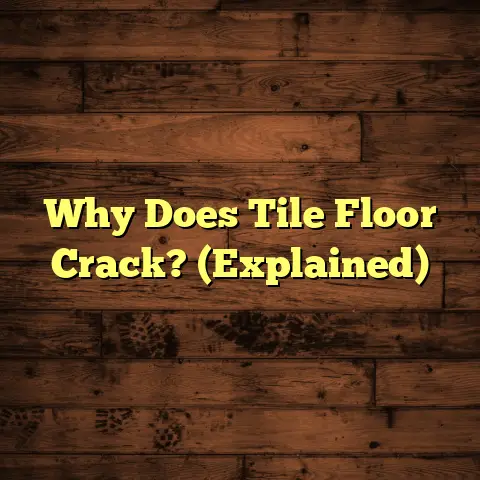Real Wood Floor Maintenance? (2 Pro Secrets!)
Unlocking the Secrets to Lasting Durability with 2 Pro Secrets!
Let’s talk about real wood floors. You know, those gorgeous surfaces that can really make a house feel like a home? I’ve seen it time and again – a beautiful wood floor can completely transform a space.But here’s the thing: a lot of folks think wood floors are super high- maintenance. They worry about every little scratch or spill. And sure, wood floors do require some TLC, but the truth is, with the right approach, they can last for generations.
I’m talking about floors that become family heirlooms, floors that tell stories. And that’s what I want to share with you today – how to unlock that lasting durability. We’ll bust some common myths and dive deep into effective care strategies that I’ve learned over years of being a flooring contractor. Ready? Let’s get started!
Section 1: Understanding the Durability
of Real Wood Floors
Now, let’s get into the nitty-gritty of what makes real wood floors so darn durable. It’s not just about the pretty surface; it’s about the wood itself!
Think about it: different wood species have different densities and hardness. Oak, for example, is a classic choice because it’s naturally tough and resistant to wear and tear. Maple is another great option, known for its tight grain and smooth finish. Cherry is beautiful, but it’s a bit softer, so it might show scratches more easily.
Here’s a quick look at the Janka hardness scale, which measures the relative hardness of different wood species:
| Wood Species | Janka Hardness |
|---|---|
| Brazilian Walnut (Ipe) | 3680 |
| Hickory | 1820 |
| Hard Maple | 1450 |
| Red Oak | 1290 |
| Cherry | 950 |
| Pine (Southern Yellow) | 870 |
Source: National Wood Flooring Association (NWFA)
See how much the hardness varies? That makes a HUGE difference in how well your floor holds up.
But it’s not just about the species. It’s also about how the wood is finished. The finish acts like a shield, protecting the wood from moisture, scratches, and everyday wear.
I’ve seen floors with cheap, flimsy finishes that are basically begging to be ruined. And I’ve seen floors with high- quality finishes that can withstand years of abuse and still look amazing.
Maintenance is the key to prolonging the lifespan of your wood flooring. Think of it like this: you wouldn’t buy a fancy car and then never change the oil, right? Same goes for your floors! Regular care can prevent minor issues from turning into major headaches down the road. Does that make sense?
Section 2: The Importance of Regular
Maintenance
Okay, so you know that maintenance is important. But what does that actually look like in practice?
First off, regular sweeping and vacuuming are your best friends. I recommend doing this at least once a week, or even more often in high-traffic areas. Dirt and grit act like sandpaper on your floors, so getting rid of them is crucial.
And when you vacuum, make sure you use a soft brush attachment to avoid scratching the finish. Trust me, those little scratches add up over time!
Mopping is also important, but you need to be careful. Never use a soaking wet mop! You want the mop to be damp, not dripping. Excess water can seep into the wood and cause warping or staining.
I always recommend using a wood floor cleaner that’s specifically designed for your type of finish. Avoid harsh chemicals or abrasive cleaners, as these can damage the finish and dull the shine.
Environmental factors also play a big role. Humidity can cause wood to expand and contract, which can lead to warping or cracking. Sunlight can fade the finish over time. And extreme temperature changes can also stress the wood.
Here are a few tips for mitigating these risks:
-
Control humidity: Use a humidifier or dehumidifier to maintain a consistent humidity level in your home (ideally between 30% and 50%).
-
Use curtains or blinds: Protect your floors from direct sunlight, especially during the hottest part of the day.
-
Maintain a consistent temperature: Avoid drastic temperature fluctuations in your home.
-
Use mats and rugs: Place mats at entrances to trap dirt and moisture, and use rugs in high-traffic areas to protect the finish.
I cannot stress enough the importance of using the right cleaning products. I’ve seen so many floors ruined by people using the wrong stuff. Always read the manufacturer’s instructions and test the cleaner in an inconspicuous area before applying it to the entire floor.
Section 3: Pro Secret #1: The Power of
Professional Finishing
Alright, let’s get to the first pro secret! And it’s a big one: the power of a professional finish.
I know, I know – it might seem like an obvious thing, but you’d be surprised how many people skimp on the finish. They think, “Oh, I’ll just slap on a coat of polyurethane and call it a day.” But trust me, that’s a recipe for disaster.
A professional finish involves a multi- step process that includes sanding, staining (if desired), and sealing. Sanding creates a smooth, even surface for the finish to adhere to. Staining adds color and enhances the natural grain of the wood. And sealing provides a protective barrier against scratches, stains, and moisture.
But here’s the key: it’s not just about the process, it’s about the products you use. Professional-grade finishes are formulated to be more durable and longer- lasting than the stuff you can buy at your local hardware store.
I’m talking about finishes that can withstand heavy foot traffic, spills, and even pet accidents. Finishes that won’t yellow or fade over time. Finishes that will keep your floors looking beautiful for years to come.
I’ve talked to countless flooring experts over the years, and they all agree: investing in a high-quality finish is one of the best things you can do for your wood floors. It might cost a bit more upfront, but it will save you money in the long run by preventing costly repairs and refinishing.
Think of it this way: you’re protecting your investment. You’ve already spent good money on your wood floors, so why not spend a little more to ensure that they last?
I’ve seen people who tried to save money by using cheap finishes, and then they had to refinish their floors after just a few years. Talk about a false economy!
Here’s a quick comparison of different types of wood floor finishes:
| Finish Type | Durability | VOC Level |
|---|---|---|
| Oil-Based Polyurethane | High | High |
| Water-Based Polyurethane | Medium | Low |
| Moisture-Cured Urethane | Very High | High |
| Acid-Cured Finish | Very High | Very High |
| Wax | Low | Low |
Note: VOC stands for volatile organic compounds.
As you can see, there are trade-offs to consider. Oil-based polyurethane is very durable, but it has a high VOC level, which means it can release harmful fumes into the air. Water-based polyurethane is more eco-friendly, but it’s not as durable.
The best option for you will depend on your specific needs and preferences. But whatever you choose, make sure you go with a professional-grade product.
Section 4: Pro Secret #2: Seasonal Care
Strategies
Okay, let’s move on to pro secret number two: adapting your maintenance routines to the changing seasons. This is something that a lot of people overlook, but it can make a huge difference in the long-term health of your wood floors.
Think about it: each season brings its own unique challenges. In the winter, you have to deal with snow, salt, and dry air. In the summer, you have to contend with humidity, heat, and increased foot traffic.
Here’s a breakdown of seasonal challenges and how to address them:
Winter:
-
Challenge: Snow and salt tracked in from outside can damage the finish and cause staining. Dry air can cause wood to shrink and crack.
-
Solution: Place mats at entrances to trap snow and salt. Use a humidifier to maintain a consistent humidity level. Clean floors regularly with a wood floor cleaner to remove salt residue.
Spring:
-
Challenge: Increased moisture from rain and melting snow can cause wood to swell. Allergens like pollen can settle on floors and trigger allergies.
-
Solution: Use mats and rugs to protect floors from moisture. Clean floors regularly with a damp mop to remove allergens.
Summer:
-
Challenge: High humidity can cause wood to expand. Increased foot traffic can lead to scratches and wear.
-
Solution: Use a dehumidifier to maintain a consistent humidity level. Place rugs in high-traffic areas to protect the finish. Clean floors regularly with a wood floor cleaner.
Fall:
-
Challenge: Falling leaves and debris can be tracked in from outside. Dry air can cause wood to shrink.
-
Solution: Place mats at entrances to trap leaves and debris. Use a humidifier to maintain a consistent humidity level. Clean floors regularly with a wood floor cleaner.
I also recommend using seasonal products that can enhance the performance of your wood flooring. For example, in the winter, you might want to use a wood floor conditioner to help prevent drying and cracking. In the summer, you might want to use a wood floor protectant to shield against UV damage.
I’ve found that using a humidifier in the winter makes a HUGE difference. It keeps the air from getting too dry, which prevents the wood from shrinking and cracking. And in the summer, a dehumidifier helps to keep the humidity in check, which prevents the wood from swelling.
Section 5: Repair and Restoration
Techniques
Even with the best maintenance, accidents happen. Scratches, dents, and water damage are all common issues that can arise with real wood floors.
The good news is that most of these issues can be repaired or restored. The key is to address them promptly before they get worse.
Here are a few common repair techniques:
-
Scratches: Minor scratches can often be buffed out with a scratch repair kit. Deeper scratches may require sanding and refinishing.
-
Dents: Dents can sometimes be removed by steaming the wood to raise the grain. Deeper dents may require filling with wood filler.
-
Water damage: Water damage can cause staining, warping, and even rot. Mild water damage can often be repaired by drying the wood thoroughly and refinishing the affected area. Severe water damage may require replacing the damaged boards.
I always recommend trying DIY methods for minor repairs, but don’t hesitate to call in a professional for more serious issues. Trying to fix a major problem yourself could end up making things worse.
I remember one time, a homeowner tried to repair a water-damaged floor himself, and he ended up using the wrong type of wood filler. The filler didn’t match the color of the floor, and it looked terrible. He ended up having to hire me to redo the entire repair.
It’s also important to address issues quickly. A small scratch can turn into a big problem if it’s not taken care of. Water damage can spread rapidly and cause extensive damage if it’s not addressed promptly.
Section 6: Long-Term Benefits of Proper
Maintenance
Okay, so we’ve covered a lot of ground here. But let’s take a step back and talk about the big picture: the long-term benefits of proper maintenance.
I’m talking about improved aesthetics, increased property value, and extended lifespan. When you take care of your wood floors, they look better, last longer, and add value to your home.
I’ve seen it time and time again: homes with well-maintained wood floors sell for more than homes with neglected floors. Why? Because people appreciate the beauty and durability of real wood.
And it’s not just about the money. It’s also about the enjoyment you get from living in a home with beautiful floors. Wood floors add warmth, character, and style to any space.
I talked to a homeowner a while back, and she said that her wood floors were one of her favorite things about her home. She said that they made her house feel cozy and inviting, and that she loved the way they looked.
And that’s what it’s all about, right? Creating a home that you love. And proper maintenance is a key part of that.
I’ve worked with clients who have had their original wood floors for over 50 years! And they still look amazing because they’ve taken good care of them. It’s truly an investment that pays off.
Conclusion:
So, there you have it! The secrets to unlocking the lasting durability of real wood floors. It’s all about understanding the inherent qualities of the wood, implementing a regular maintenance routine, investing in a professional finish, and adapting your care strategies to the changing seasons.
I know it might seem like a lot of work, but trust me, it’s worth it. A little effort in maintenance can lead to significant rewards, ensuring beauty and functionality for generations to come.
Don’t let your wood floors become just another floor. Let them become a part of your family’s story. Take care of them, and they’ll take care of you.
Now go forth and conquer those floors! You got this!





